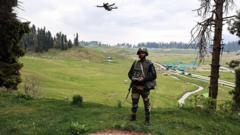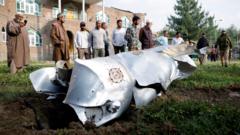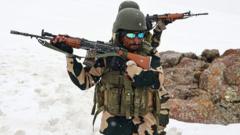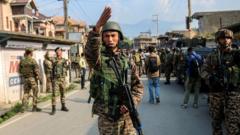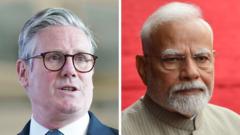Following the latest deadly attack in Kashmiri Pahalgam, the region's turmoil brings back memories of past India-Pakistan conflicts, igniting discussions about the thin line between escalation and diplomacy.
**India-Pakistan Tensions Resurge: A Historical Perspective on De-escalation Strategies**
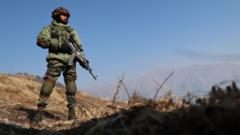
**India-Pakistan Tensions Resurge: A Historical Perspective on De-escalation Strategies**
As India and Pakistan confront renewed tensions following a deadly attack in Kashmir, experts reflect on past strategies for crisis management.
In the aftermath of a tragic militant attack in Pahalgam that left 26 civilians dead, tensions between India and Pakistan have escalated, reminiscent of previous crises that defined their tumultuous relationship. This situation reflects a troubling pattern; similar incidents have occurred in the past, including the 2016 Uri attack and the disastrous 2008 Mumbai attacks, each time leading to heightened conflict and decisive military responses.
In 2019, the deadly Pulwama bombing, claiming 40 paramilitary lives, prompted India to launch airstrikes on Balakot—an unprecedented move targeting militant positions inside Pakistan since 1971. These events have led to a notable shift in India’s military strategy, with cross-border strikes becoming increasingly normalized. Ajay Bisaria, a former Indian high commissioner to Pakistan, has been vocal about the parallels between past and present crises, particularly highlighting the difference that the latest assault, which targeted civilians rather than military personnel, brings to the landscape of conflict.
The swift and retaliatory actions taken by India post-attack include closing key borders, halting diplomatic engagement, and intensifying military presence along the Line of Control as skirmishes erupted. This aggressive stance was manifested in banning Pakistani flights from Indian airspace and suspending visas for Pakistani nationals. Pakistan, in turn, took similar measures, raising questions about future diplomatic channels.
Bisaria's insights shed light on the balancing act India has to perform—striving for deterrence while avoiding full-scale military confrontations. Despite the prevailing animosities, he remarks on the instinct for de-escalation that underlies both nations' decisions, particularly amidst increasing global scrutiny and economic implications of prolonged conflict.
Historical context plays a crucial role here. Following the Pulwama incident, India's Cabinet Committee on Security moved rapidly to impose economic sanctions on Pakistan and curtailed trade agreements. This sequence of events illustrates how confidence can rapidly erode in the face of violence and threats.
Furthermore, communication lines, including military hotlines, remain vital for both sides. The ongoing diplomatic discourse, despite the chaos on the ground, reflects a mutual understanding that gross military escalation could override gains made in peaceful negotiations over decades. The precarious nature of this relationship is underscored by the looming dilemma of the Indus Waters Treaty—which, if annulled by India, could have dire ramifications for Pakistan’s water security.
As the situation in Kashmir continues to unfold, Bisaria emphasizes the need to recognize that crisis can lead to a comprehensive reassessment of diplomatic ties. “We haven't yet seen any kinetic military action,” he warns, indicating that the possibility of further escalation remains tangible.
The world watches closely as these two nuclear powers navigate the treacherous waters of historical grievances and modern tensions, hoping that wisdom will prevail over warfare.
In 2019, the deadly Pulwama bombing, claiming 40 paramilitary lives, prompted India to launch airstrikes on Balakot—an unprecedented move targeting militant positions inside Pakistan since 1971. These events have led to a notable shift in India’s military strategy, with cross-border strikes becoming increasingly normalized. Ajay Bisaria, a former Indian high commissioner to Pakistan, has been vocal about the parallels between past and present crises, particularly highlighting the difference that the latest assault, which targeted civilians rather than military personnel, brings to the landscape of conflict.
The swift and retaliatory actions taken by India post-attack include closing key borders, halting diplomatic engagement, and intensifying military presence along the Line of Control as skirmishes erupted. This aggressive stance was manifested in banning Pakistani flights from Indian airspace and suspending visas for Pakistani nationals. Pakistan, in turn, took similar measures, raising questions about future diplomatic channels.
Bisaria's insights shed light on the balancing act India has to perform—striving for deterrence while avoiding full-scale military confrontations. Despite the prevailing animosities, he remarks on the instinct for de-escalation that underlies both nations' decisions, particularly amidst increasing global scrutiny and economic implications of prolonged conflict.
Historical context plays a crucial role here. Following the Pulwama incident, India's Cabinet Committee on Security moved rapidly to impose economic sanctions on Pakistan and curtailed trade agreements. This sequence of events illustrates how confidence can rapidly erode in the face of violence and threats.
Furthermore, communication lines, including military hotlines, remain vital for both sides. The ongoing diplomatic discourse, despite the chaos on the ground, reflects a mutual understanding that gross military escalation could override gains made in peaceful negotiations over decades. The precarious nature of this relationship is underscored by the looming dilemma of the Indus Waters Treaty—which, if annulled by India, could have dire ramifications for Pakistan’s water security.
As the situation in Kashmir continues to unfold, Bisaria emphasizes the need to recognize that crisis can lead to a comprehensive reassessment of diplomatic ties. “We haven't yet seen any kinetic military action,” he warns, indicating that the possibility of further escalation remains tangible.
The world watches closely as these two nuclear powers navigate the treacherous waters of historical grievances and modern tensions, hoping that wisdom will prevail over warfare.




